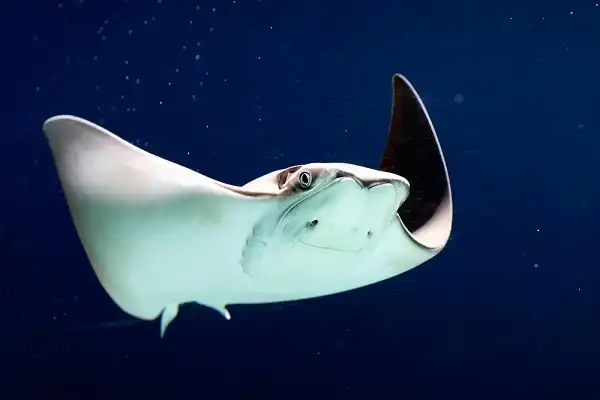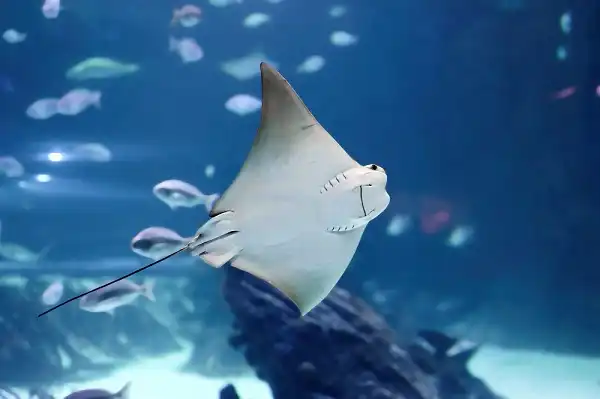Have you ever seen a stingray up close? These amazing creatures are often thought of as dangerous, but they are actually gentle and graceful animals. Come see these beautiful animals for yourself at the aquarium! You can even touch them and feel their smooth skin. Just be careful not to get stung!

Stingray Description
Stingrays are cartilaginous fish that are closely related to sharks. They have flat diamond-shaped bodies and long tail fins, which they use to help them swim. They can range in size from under 6 inches to up to 9 feet in length! Their skin is smooth and often patterned with spots or stripes, which helps them blend into the ocean floor. Stingrays have powerful venomous stingers located on their tails that they use for defense against predators. However, contrary to their reputation, stingrays will usually only sting if they feel threatened and it is not common for humans to be stung by a stingray.
Stingray Habitat
Stingrays can be found inhabiting a wide range of habitats from shallow water coral reefs to the depths of the open ocean. They are especially common in tropical and subtropical waters, where they often live on sandy or muddy sea floors. Stingrays typically prefer shallow water because it allows them to blend in with the surrounding environment more easily and provides an ample supply of food sources. In addition to these shallow waters, some species of stingrays will also inhabit deeper offshore environments as well. Here, they have fewer predators and plenty of room to maneuver around. The greater depth also provides a cooler temperature than the surface and allows them to hide from potential threats more easily.
Stingrays are also capable of living in freshwater habitats such as lakes, rivers, and streams, but this is not very common due to their saltwater origins. Some species even travel between saltwater and freshwater areas seasonally depending on their feeding needs. This type of habitat is most likely to be found along estuarine coasts where their prey is plentiful and their predators are few. No matter where they call home, stingrays require areas with an abundance of hiding places such as rocks, coral reefs, shipwrecks, and other structures that offer protection from predators like sharks and seals. These creatures will often bury themselves in the sand or mud during the day when they’re resting or seeking refuge from danger.
Stingray Diet
Stingrays are opportunistic predators that feed primarily on small fish and invertebrates such as shrimp, crabs, clams, and worms. Stingrays have powerful electroreception organs in their head that allow them to sense electrical fields created by small prey hiding in the sand or mud of the ocean floor. To capture their prey, stingrays open their mouth wide and suck them in like vacuum cleaners! They also possess sharp crushing plates in their mouths which help them crush mollusks and other hard-shell organisms. In addition to these smaller prey items, some species of stingray will also hunt larger fish such as eels and flounders when they can find them. These larger meals are important sources of nutrition for stingrays, especially during the winter months when food is scarce. Overall, stingray diets vary from species to species depending on the resources available in their chosen environment. For example, freshwater stingrays tend to eat more insects and worms than their saltwater counterparts due to a lack of mollusks and crustaceans in these habitats. Similarly, some species may prefer live prey while others are content with scavenging for dead fish or other organic matter on the sea floor.

Stingray Size
Stingrays come in a variety of sizes, ranging from small species only a few inches long to much larger ones that can be up to 6 feet across. The largest species are the giant manta rays, which can grow as big as 23 feet in width and weigh up to 2 tons! Though these may be the biggest, there are many other big species of stingray including porcupine rays, devil rays, cow nose rays, and Eagle Rays. The size of an individual stingray depends on both its species and its gender. Generally speaking, male stingrays tend to be smaller than their female counterparts with some exceptions. For example, while manta rays typically reach 13 feet in length for mature males and 18 feet for mature females some smaller species such as the Atlantic stingray have very little size difference between genders. To remain healthy and active, it’s important for stingrays to have plenty of space to move around so bigger is usually better when selecting a tank for them. It’s recommended that any tank housing multiple individuals should provide at least 20 gallons of water per fish or 45 gallons if you’re keeping just one large specimen. With proper care, even large specimens can be kept quite comfortably so don’t let size alone deter you from providing a great home for your new pet!
Stingray Lifespan
Stingrays can live for a remarkably long time, with some species reported to have lifespans of up to 25 years in the wild. The oldest known specimen was a female freshwater stingray caught in South America which was estimated to be over 40 years old when it was harvested. In captivity, stingrays tend to live slightly shorter lives due to stress and poor water quality. The lifespan of any particular stingray largely depends on its species and size, with larger species typically living longer than their smaller counterparts. This is because larger specimens have better-developed immune systems that are better able to withstand disease and other environmental threats such as predators or parasites. Additionally, larger rays also tend to reproduce less often so they have fewer opportunities for injury or death during mating season. In general, stingrays tend to reach sexual maturity by the age of 4 or 5 and can then go on to produce several litters throughout their lifetime. Older specimens may become slower and more reclusive in their later years but still remain relatively active until the very end.
Stingray Behavior
Stingrays are highly adapted to their marine habitat, possessing a variety of behaviors that help them survive in the wild. Perhaps one of their most recognizable traits is their ability to bury themselves in the sand, making them virtually invisible to predators and allowing them to ambush prey as it passes by. This behavior is often referred to as “cryptic behavior” and they can remain motionless for long periods of time while waiting for food. In addition to burying themselves in the sand, stingrays also have several other ways of protecting themselves. For starters, their venomous barbs can be used defensively against potential threats—the venom is released upon contact and although not always fatal it can cause extreme pain and swelling if left untreated. Additionally, stingrays also possess a protective shield on their back known as an “operculum” which can help to cushion blows from predators or prey alike. Stingrays are social creatures that will often congregate in groups when hunting or during times of stress such as during the mating season. These gatherings can range in size from just two individuals up to hundreds depending on how many individuals live within an area as well as how much food is available for them to consume. During these times males will compete with one another by trying to outswim potential rivals or pushing each other away using their fins. Females meanwhile typically remain close together while they rest or feed before moving off on their own once again afterward.

Stingray Speed
Stingrays are known for their impressive speed, which can be attributed to their streamlined body shape and powerful pectoral fins. Underwater, they are capable of reaching speeds of up to 30 miles per hour! This incredible amount of power can allow them to outmaneuver potential predators in a matter of seconds and quickly catch their prey. The powerful muscles that make up the stingray’s fins also play an important role in propelling the animal forward. When swimming, a stingray will use its large pectoral fins as hydrofoils in order to generate lift and thrust itself through the water at impressive speeds. This specialized method is much more efficient than most other fishes’ mode of propulsion, allowing stingrays to cover long distances quickly with minimal effort. When hunting or defending itself, a stingray’s speed is especially impressive—it can instantly launch itself out of danger or close the gap between it and its prey much faster than many other aquatic creatures. In addition to speed, this combination of agility and power makes it almost impossible for predators larger than a few inches in size to successfully attack a full-grown stingray unless they have an element of surprise on their side.
Stingray Hunting
Stingray hunting is an important part of the marine food chain, allowing these animals to maintain and replenish their population levels in their respective environments. Stingrays are active predators, and often take advantage of their superior speed by stalking, ambushing, and attacking their prey from below. This unique hunting style allows stingrays to surprise their prey before they can react, allowing them to capture small animals such as fish, crabs, shrimp, worms, and mollusks in a single strike with their powerful tails.
When hunting in shallow areas where visibility is higher, stingrays will often use the sand or seagrass as camouflage. Stingrays can bury themselves into the ocean floor using specialized structures on their ventral sides known as “ampullae of Lorenzini”. This helps them to lie motionless while they wait for unsuspecting prey to swim close enough for them to strike. Stingrays also have excellent eyesight which allows them to distinguish between different types of food sources even when visibility is poor. They are also capable of detecting minute movements in the water that could indicate the presence of a potential meal nearby. When a suitable target is detected, stingrays will quickly accelerate toward it using powerful strokes of their fins before catching it with their mouths or stingers on their tail.

Conclusion
The incredible speed and agility of stingrays make them formidable predators in their respective environments. Thanks to their flattened bodies, they are able to cover great distances quickly while their powerful tails help propel them forward at lightning speeds. Additionally, they employ a unique hunting strategy that combines stealthy tactics such as sand or seagrass camouflage with quick reflexes and keen eyesight to surprise and capture small prey items before they can react. Finally, some species have also been known to form cooperative groups in order to hunt larger meals together – demonstrating the importance of intelligence in this amazing animal’s success. All these elements combine to make stingray hunting one of the most impressive feats of nature – proving just how well-adapted these animals are for life in the sea
Frequently Asked Question

